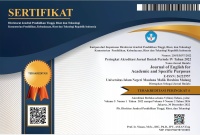IMPLEMENTING SSS (START WITH SIMPLE STORIES) METHOD TO IMPROVE STUDENTS’ READING COMPREHENSION IN EXTENSIVE READING ACTIVITY
Abstract
Full Text:
PDFReferences
Akio, F. 2006. SSS METHOD Extensive Reading Method Proves to be an Effective Way to Learn English, (On line), (http://www.seg.co.jp/SSS Method/, accessed on February 21, 2009)
Ary, D, Lucy C. J., Asghar R. 1985. Introduction to Research in Education (3rd Ed). New York: CBS College Publishing.
Bell, T.1998. Extensive Reading: Why? and How? The Internet TESL (Online Journal) Vol. IV, No. 12 (http://iteslj.org/Articles/Bell-Reading.html/, accessed on February 21, 2009)
Brown, H. D. 2001. Teaching by Principles: An interactive Approach to Language Pedagogy (2nd Ed). New York: Pearson Education
Brown, R. 2000. Extensive Reading in the EFL Class (Extensive Reading in Practice Colloquium. Paper presented on JALT International Conference November 2000, Fukuoka. Seinan Gakuin University. (Online), (http://extensivereading.net/er/rbrown.html, accessed on February 22, 2009)
Burns, P. C., Roe, B. D., Ross, E.P. 1996. Teaching Reading in Today’s Elementary school (6th Ed). Boston: Houghton Mifflin
Day, R. R. and J. Bamford. 1998. Extensive Reading in the Second Language Classroom. Reviewed by Willy A Renandya, George M Jacobs, & Vivienne Wai-Sze Yu. RELC Journal, (Online), 29(2), 1998, (http:// extensivereading.net/er/RenJacRev.html, accessed on February 21, 2009)
Depdiknas.2006. Standar Isi Mata Pelajaran Bahasa Inggris untuk SD/MI, SMP/MTs, SMA/MA. Jakarta; Balitbang Depdikna.
Meng, F. 2009. Developing Students’ Reading Ability through Extensive Reading. English Language Teaching. Vol. 2, No. 2, (http://ccsenet.org/ journal/index.php/elt/article/viewFile/2378/2240, accessed on February 22, 2009)
Hatch, E. & Farhady, H.1982. Research Design and Statistics for Applied Linguistics. Rowley Massachusetts: Newbury House
Renandya, W.A. & Jacobs, M (1999). Extensive Reading: Why Aren’t We All Doing It? In Richard, J. C. & Renandya, W. A. (Eds.). 2002. Methodology in Language Teaching: An Anthology of Current Practice. USA: Cambridge University Press.
DOI: https://doi.org/10.18860/jeasp.v5i1.16583
Refbacks
- There are currently no refbacks.





Editorial Office:
Pusat Pengembangan Bahasa
Program Khusus Pengembangan Bahasa Inggris (PKPBI)
Universitas Islam Negeri Maulana Malik Ibrahim Malang
Gedung C lantai 1
Jl. Gajayana No 50 Kota Malang, Jawa Timur, Indonesia
Kode Pos 65144, Telp/Fax : (0341) 570872
Email: jeasp@uin-malang.ac.id







